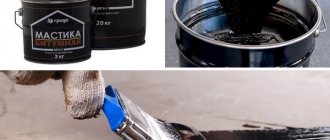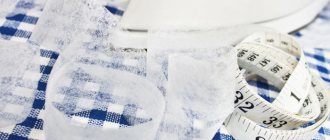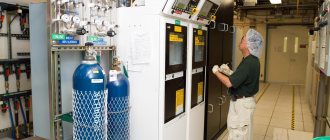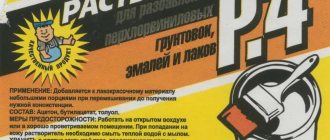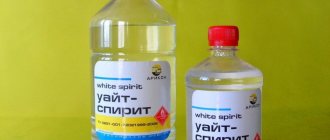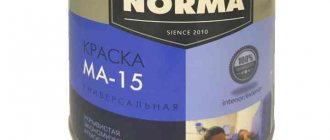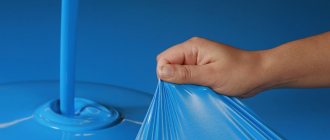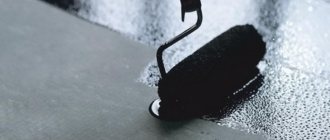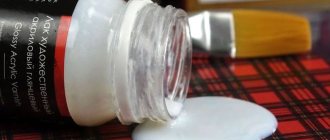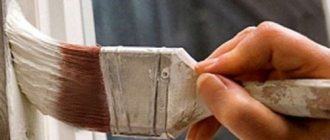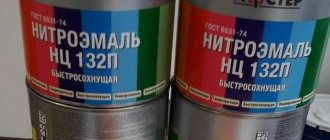The problem of increasing the corrosion resistance of painted surfaces has not lost its relevance to this day. The first and most necessary operation in the surface preparation process before painting is degreasing.
If you do not degrease the surface, you will not be able to achieve good adhesion, and the paint will begin to peel off very quickly in those places where there were stains and dirt. In most cases, surface degreasing is performed using organic solvents. But what solvent should I choose for this and how is this work done correctly? Let's take a closer look at this question: does solvent 646 degrease and is it always possible to use it?
Advantages and disadvantages of the product
Summarizing the advantages of p-646, we highlight its high effectiveness and guaranteed results. Solvent 646 does not leave difficult-to-remove marks on the treated surface, which cannot be said about its analogues. Therefore, it can be used to clean even transparent or colored coatings without the risk of spoiling them.
Solvent 646: safety precautions
When starting to work with the P646, carefully read the manufacturer's instructions. It specifies the principles of operation and rules for using the composition with a guarantee of safety for the health of the master.
Arm yourself with gloves and a respirator so that the substance does not damage the skin of your hands and respiratory tract. The work area must be well ventilated.
Description and composition of solvent 646
What is solvent 646? This is a colorless liquid (although a yellow tint is possible) with a distinct odor. Manufactured according to GOST 18188-72 standard. The liquid itself is homogeneous, without sediment or turbidity. It shouldn't peel off. Can be used in everyday life and industry.
The special composition of this solvent has made it one of the most popular among analog products. Compound:
- acetone – 7%;
- ethyl cellosolve – 8%.
- butyl acetate – 10%;
- ethyl alcohol – 10%;
- butanol – 15%;
- toluene - 50%.
Important!
You should purchase this solvent only from trusted companies. These include: “Polikom”, “Yashim”, “Dmitrievsky Plant”, Verkhnevolzhskaya Paint and Varnish Factory. They produce solvent 646 in accordance with the requirements of GOST 18188-72.
Available in different containers. So, for use in industry, it is bottled in large containers and metal containers. For home use, it is bottled, glass or plastic canisters, and small metal barrels.
Solvent composition 646
How to degrease metal before painting
In domestic conditions, owners, as a rule, use proven “old-fashioned” products - gasoline, kerosene, acetone, alcohol.
But today more modern and technologically advanced formulations are available. Among them, Nefras (White Spirit), Solvent 646 are quite popular. They have a lot of advantages - affordable price, increased level of environmental friendliness, the ability to form films that are more resistant to paintwork, which helps prevent the development of corrosion processes.
Flow R646
The solvent is added to the paint base in small parts with constant stirring until the desired degree of viscosity is achieved.
P646 is highly reactive, so handling this product requires care, otherwise the surface being treated may be damaged.
Material consumption for degreasing per 1 sq. m is:
- for facade work the required volume will be 0.147 l;
- for metal or wood surfaces indoors – 0.12 l;
- for a layer of concrete – 0.138 l;
- for all types of surfaces in conditions of high humidity - 0.169 l.
Solvent 646 is rightfully considered one of the most effective solvent compositions, which is why it is widely used in the repair of technological equipment.
- Together with XB-784 varnishes. They are often used in production workshops to cover tanks for decarbonizing water and chemical cleaning liquids, condensate tanks, water desalination tanks and cleaning pipelines. Varnishes and enamels can be used for these purposes only with solvent 646. Its standard consumption will be 0.086 l/m2.
- Together with enamel NTs-11. which is suitable for treating metal surfaces operating in changeable weather conditions with a high degree of exposure to moisture, including sea water, as well as petroleum products. P646 is used to dissolve this paint at the rate of 0.528 kg per square meter. m. covering. For non-metallic coatings operating under similar conditions, NC 1200 enamel is used; it is diluted based on the standard of 0.147 l/m2.
- For internal repair work, preference should be given to NC-25 enamel. The proportion of its dilution is 0.120 liters per square meter of surface.
To protect porous layers of concrete and brick from the adverse effects of alkalis and acids, putty is used. At the same time, it can demonstrate its more effective consumer properties only when diluted with a high-quality solvent - this will require 1.2 liters of P646 per square meter. If putty is used to protect the insides of lighting tanks, containers for acid-base compounds and the insides of sodium cation filters, the solvent consumption will be lower - 0.138 l/m2.
EP-5116 enamel, used for treating the coating of pipelines and oil settling tanks, is diluted with a solvent at a ratio of 0.169 liters per square meter.
Sandblasting
Before using certain compounds to degrease the part, it is subjected to mechanical processing. This allows you to remove mechanical impurities, rust, and partially old paint and varnish coatings and facilitates the work of the degreaser.
To do this, use sandpaper or abrasive wheels driven into rotation by an angle grinder. This method is good for small parts. If you need to prepare a large part for painting, sandblasting comes into play.
High-pressure air passing through the nozzle carries along the sifted grains of sand, they hit the surface with force and act as an abrasive material. The flow of sand grains removes all mechanical impurities, rust and old paint from the part. The surface remains rough, which improves its adhesion to glue or paint. In addition to metal, sandblasting is used for hard plastics, wood and stone.
Sandblasting
After sandblasting, the part must be washed with clean water under pressure to wash away any remaining sand and dust and dried with compressed air. Now you can start degreasing.
After the surfaces have been cleaned before gluing, they are washed in clean water to remove small particles, dried thoroughly and degreasing begins.
Solvent 646 technical characteristics, composition, application
Solvent 646 is a colorless or yellowish liquid that has a specific odor. It is used both in everyday life and in industry for degreasing and diluting paints. Using solvent 646, you can bring the paintwork material to the required viscosity. They are also good for removing organic stains and washing various painting tools.
Solvent 646 is very versatile and effective due to its chemical composition. This is a multi-component solvent, so it contains several simpler solvents: 15% ethanol, 10% butanol, 50% toluene, 7% acetone, 10% butyl acetate and 8% ethyl cellosolve.
This brand of solvent has earned a good reputation and huge demand thanks to the following features:
• Very wide range of applications. It is excellent for thinning varnishes, primers, putties and enamels. It is used during the implementation of repair and construction work on buildings and premises for various purposes, in the process of painting cars, degreasing surfaces, and cleaning tools.
• Availability. It can be easily purchased at any building materials store.
• Ease of use. You do not need to have special knowledge to use solvent 646. Its complex composition reduces the risk of chemical burns and greasy marks to a minimum.
• Acceptable price. You should know that when using solvent p 646, its technical characteristics are more than excellent for such a low price.
Like any chemical substance, it also has some disadvantages: a strong and specific odor, toxic, and flammable.
Solvent 646 is a compound of several volatile organic substances that has the following physicochemical properties:
• Flash point - 7 °C;
• Auto-ignition temperature +4037 °C;
• Boiling point +59 °C;
• Density – 0.87 g/cm3;
• It does not gain viscosity and does not freeze.
In addition, it would not be superfluous to look at the passport of this substance, although most of the numbers will not tell the average person anything, but the production technologist can prohibit and give recommendations for use based on these parameters.
Solvent brand p6 has the following indicators:
• Acid number - 0.06 mg KOH/g;
• Mass fraction – 0.09%;
• Volatility (based on ethyl ether) – 12;
• Solvent action – does not leave whitish or matte stains;
• Coagulation number 40 g/o;
• Specific gravity – 0.68 kg/l.
The solvent is used for the production and work with various paints and varnishes, including the nitrocellulose group of paints. R-646 is needed either for dilution before use or during production. In addition to the nitrocellulose group of paints, it is also used for diluting acrylic and melanin amide paints and varnishes.
When working with solvent 646, be sure to use a respirator and wear rubber gloves. Good ventilation is also very important. Special protective glasses will not be superfluous, since the evaporation of the solvent affects not only the respiratory system, but also the eyes.
Degreasing metal
In addition to grease and dirt, metal often contains rust, paint, and sealant residues. For metal processing you should choose white spirit, acetone, gasoline.
The procedure is as follows:
- Remove rust, paint, sealing residues with a grinder, manually, grinder, sandpaper - in any convenient way (the bathtub in the house is treated with a sponge and soda). It is better to clean large areas with a power tool.
- Moisten a cloth with solvent and treat the product until completely clean. If the parts are small, you can simply immerse them in solvent.
- After complete drying, you can apply primers and paints. Those areas that cannot be painted should be covered with double-sided tape.
Specifications
P646 is sold in liquid form. The composition is transparent, rarely with a yellowish tint.
Its formula determines the technical parameters:
- the density of the substance is 0.87 g/cm3, which is why it is ideally mixed with other solvents and paints and varnishes;
- volatility coefficient ranges from 8 to 15;
- coagulation number – more than 35%;
- acid number – less than or equal to 0.06 mg KOH/g;
- the specific gravity of water does not exceed 2% (according to Fischer);
- boiling point - 59 degrees;
- spontaneous combustion temperature – 403 degrees;
- no freezing;
- no viscosity gain;
- hazard class – III.
The production technology and packaging of the solvent is based on the GOST 18188-172 standard.
When purchasing, pay attention to the structure of the liquid. The composition must be homogeneous, without separation and the formation of cloudy sediment
The mixture should not contain suspended particles.
Sold in metal containers, as well as in glass or durable plastic containers with volumes of 1-10 liters. The composition is completely ready for use and does not require preliminary preparation. Maintains its performance characteristics for 12 months. After the expiration date, the solvent is not recommended for use.
Traditional degreasers
Often, when servicing a car, the most common degreasers are used.
For the initial treatment of small areas of contamination, you can successfully use gasoline, kerosene and even diesel fuel. Primary treatment consists of preparing the surface of the iron for degreasing. For example, the manufacturer recommends using BR-2 solvent, also known as Galosh gasoline, for washing metal products.
This recommendation can be successfully applied to kerosene and diesel fuel (“diesel fuel”). By the way, gasoline or kerosene can be used to thoroughly clean and degrease leather and fabric products. The only drawback is that the smell will take a long time to dissipate.
This is interesting! What is drying oil: types, composition, technical characteristics and application features
What are the consumption rates for 1 sq.m2
When you want to use it, you need to know exactly what varnishes and paints it can be used with, how much you need to add
It is important to understand that the consumption when degreasing surfaces, as well as diluting varnishes and paints, differs significantly. Moreover, the solvent consumption will not be the same when diluting different types of varnishes and paints
To determine the optimal consumption per m2, you need to take into account the technical conditions, as well as the standards of paints and varnishes. Experimental studies are being carried out
The general degree of dilution of paintwork materials determines the solvent consumption rates for a particular substance.
In order to properly dilute nitrocellulose putty NTs-00-7, according to state standards, you will need to use 1.23 kg/t of solvent. To dilute nitroglyphthalic enamels NTs-132 and NTs-1200, you will need 1.17 and 0.85 kg/t, respectively.
Since solvent 646 is one of the most effective when compared with other multicomponent substances, it is in high demand in the construction of special-purpose facilities, as well as in the repair and maintenance of complex equipment.
HV-784 varnish and EP-00-10 putty are used for industrial purposes, as well as to ensure reliable protection of the internal surfaces of tanks and pipelines. They are highly effective, but can only be used if diluted with solvent 646. For such substances, 0.086 kg/m2 should be used.
If equipment or mechanisms are used in unfavorable atmospheric conditions, constant contact with oil products or salt water, they must be painted with NTs-11 enamel. In order to dilute it, solvent 646 is also suitable. It will require 0.528 kg per square meter.
The outer surfaces of metal mechanisms, which are also used in conditions of adverse atmospheric influences, constant contact with salt water or petroleum products, must be coated with NTs-1200 enamel diluted with solvent 646. It will require 0.147 kg per square meter.
When using NC-25 enamel, which is intended for painting indoor wood and metal surfaces, it must also be diluted with this solvent. For such purposes, the P-646 norm is 0.120 kg per square meter.
To protect the surface of concrete structures from the negative effects of aggressive substances such as acids and alkalis with a pH level of 6.0 - 10.0, it is necessary to use EP-00-10 putty. But it will protect effectively only if you use solvent 646 in an amount of 1.2 kg/m2.
In order to create effective protection for the interior of equipment such as pipelines, oil settling tanks and cooling towers, EP-5116 Enamel is used. It is suitable for the protective purpose of steel and concrete structures from atmospheric influences, moisture, as well as aggressive substances such as alkalis, solutions of phosphoric and nitric acids, saline solutions, etc. Solvent 646 is perfect for diluting enamel. It will require 0.169 kg per square meter.
You can buy high-quality solvent from our company that fully complies with the requirements of state standards. The price of the product is more than affordable.
Aqueous solutions
Water itself is not an ideal liquid for degreasing surfaces - just remember attempts to wash greasy dishes with cold water. This is due to its high surface tension and its inability to emulsify fats.
To make surface degreasing with aqueous solutions effective, the following methods are used:
- increase pH acidity level;
- heat the solution to 55-60 oC;
- add surfactants (surfactants).
Water based degreaser
Aqueous solutions are quite effective against light and medium levels of contamination. They are significantly less dangerous to use than organic solvents.
Solvent grade R 4
Technical characteristics, composition
P 4 is an organic solvent, which contains:
- Ketones.
- Aromatic hydrocarbons.
- Ethers.
- Toluene – 62%.
- Butyl acetate – 12%.
- Acetone – 26%.
This product is produced in accordance with GOST and is produced with the following series of technical characteristics:
- Appearance – transparent liquid, sometimes yellowish, without suspension.
- Water content – 0.8%.
- The volatility of the solution is from 6 to 16.
- Acid number – no more than 0.076 mg KOH g/cm3.
- Coagulation number – not less than 26%.
Application area
This product is used to dissolve and dilute putties, varnishes, primers, enamels and paints that are marked HV, HSL, XS, EP, Vinikor, Evinalgrunt-enamel XC-500, Vinicolor, Evikor. R-4 is also used for washing tools, hands, brushes and dishes after working with paints and varnishes.
It is also suitable for dissolving and liquefying varnish, enamel, primer, as well as for putty marked PVC, XC, MS, XB EP-0020, but is not suitable for gray and protective enamel XB-124. The solution is volatile, which is what its use was based on: it quickly hardens and forms a film.
Please note that water should not be allowed to enter this type of solvent and its subtype, R-4a. this can lead to whitening of the film, since acetone and water mix easily, and the composition contains enough acetone
Safety
Solvent grade P 4 is flammable, explosive and toxic, and therefore when working with it you should follow safety precautions:
- Store the composition in a well-ventilated and fireproof area, away from sunlight and in an airtight container.
- Work with solvent in a room with good ventilation.
- Use safety glasses to avoid contact with eyes.
- Wear protective gloves and avoid contact with skin, but if it does occur, wash the area well with soap and water.
The substance is toxic, and this manifests itself in narcotic effects (headache, dizziness, disorientation, cloudiness), as well as coughing, irritation of the eyes and other mucous membranes. If you inhale the vapors for a long time, there is a possibility of poisoning, and it will be similar to food poisoning, but with elements of toxic damage to the central nervous system.
For this reason, when working with the composition, use all protective equipment, work in a well-ventilated area, and if necessary, immediately seek medical help.
This brand of solvent can form explosive compounds with oxidizing agents and acids (hydrogen peroxide, nitric and acetic acid). Sometimes it is aggressive towards some types of plastic.
How to degrease plastic
Plastics are one of the largest groups of materials, containing a variety of types of plastic. Gasoline, acetone, and vinegar are perfect for a number of plastics; other materials will immediately become unusable from such substances. Universal compounds are also not always suitable for plastic.
For plastic car parts, only special products are used, which are sold in relevant stores and are suitable for plastic and rubber. At home, you can try applying white spirit to the material. An antistatic agent will be 100% safe; most products can be degreased well with vodka.
The procedure for degreasing plastic before gluing it is as follows:
- Wipe off the dust with a (dry) cloth, if necessary, wash to remove obvious dirt, and dry.
- Soak a rag with solvent.
- Gently scrub the surface.
- If in doubt, try scrubbing a small area of the product first.
Safety precautions
Solvent 646 has special operating and storage conditions. The composition is bottled in special containers: from 0.5 liter bottles to 200 liter barrels.
When transporting and storing the composition, one should not forget that the product belongs to the flammable category, therefore:
- the glass or metal container in which the material is contained must be hermetically sealed and closed, the ingress of water is strictly prohibited, and contact with direct UV radiation and elevated temperatures should be avoided;
- The room where the composition is stored should be well ventilated, and there should be an absolute absence of ultraviolet rays and fire sources.
In order for construction and finishing work using solvents to be as safe as possible, all of the following requirements must be met:
If you neglect these safety rules, the consequences can be very unpleasant:
- irritation of the eyes and respiratory tract, bronchopulmonary spasm;
- poisoning - vapors of the substance can be absorbed not only through the respiratory system, but also through the skin, and therefore can cause serious damage to the central nervous system, and in addition, to the kidneys and organs of the gastrointestinal tract;
- with prolonged contact with this solvent, severe dermatitis may occur on the skin;
- Long-term exposure of the product to the human body causes changes in the condition and structure of the bone marrow and blood.
- the storage area and working space of the solvent should be protected from contact with fire and its potential sources (sparks, unextinguished cigarettes, heating devices);
- the storage container must be fairly tightly closed, since the mixture of solvent vapor and air has explosive properties, and the accumulation of a critical dosage of vapor in the air, if the container is left open, can occur very quickly;
- it is necessary to exclude contact of the solvent with hydroperite, as well as caustic nitric and acetic acids, otherwise there is a high probability of the formation of an explosive mixture;
- The reaction of solvent 646 with substances such as bromoform and chloroform has a similar effect.
Keep in mind that solvent vapors creep downward, since they are much heavier than air, which is why any fire can start even at a distance from the fire source, especially since the composition can reach a critical concentration when combined with air even at a temperature of 20 degrees - so do not expose yourself and your loved ones at risk, try to create the most “closed” conditions for storage and use.
Properties and composition
Solvent 646 has a multi-component formula; it is an active substance that is widely used for all types of repair, finishing and construction work. It is necessary when working with enamels and nitro-based paints, and is also optimal for dissolving epoxy and glyphthalic primers. It is noteworthy that after all the volatile substances evaporate, the surface acquires a slightly shiny, glossy tint.
Typically, the solvent is colorless. But in some cases, a slight yellow tint may appear and has a pungent, unpleasant odor.
The structure of the substance consists of the following active components:
- acetone – 7%;
- ethyl cellosolve – 8%;
- ethyl alcohol – 10%;
- butyl acetate – 10%;
- butanol – 15%;
- toluene – 50%.
For the same reason, active technical work is now underway to change the composition of the solvent in such a way as to limit the scope of its illegal use.
The popularity and wide scope of use of solvent 646 is due to its high consumer characteristics:
- affordable price - this product is sold in all hardware and construction stores and has a low cost;
- practicality - especially for consumers, the label contains complete information on the method of application of the composition, thanks to which every person, even without any experience in finishing, can understand the peculiarities of the work;
- functionality - the solvent has a multicomponent structure, so it can interact with almost any type of material;
- used for high-quality degreasing of surfaces; after work it does not leave any traces on the surface;
- after treatment the surface gives it a glossy tint;
- Contact with this substance does not cause burns or irritation to the skin.
The solvent also has disadvantages, the most significant of which include:
- high degree of toxicity - the material is classified as hazard class III, which is why all work must be performed strictly using personal protective equipment (respirator, goggles and gloves);
- fire hazard - work near fire sources is strictly prohibited, smoking is prohibited near the work site;
- strong chemical odor - surface treatment should be carried out in a well-ventilated area, and care should also be taken to protect the organs of vision, since the fumes of this solvent can irritate the mucous membrane of the eyes;
- special storage conditions - it is necessary to use sealed, closed containers; the solvent can only be stored outside residential premises.
The high demand for the product has given rise to an unpleasant phenomenon - today the market is literally flooded with a large number of fakes, and in addition, users note a deterioration in quality characteristics even in products produced by well-known manufacturers.
Many consumers confuse solvents of brands 646 and 647. And in fact, in terms of their functionality and physical and technical properties, they are quite similar, in addition, both compositions are produced in small containers of 0.5 l and 1 l, for household needs and barrels - for industrial. They are produced in Russia and have a very wide application.
The difference lies in their composition. Thus, M646 includes ethanol, toluene, butyl acetate and ethylcellosolve, and 647 has the same components, except for acetone. Due to this, it is less aggressive and more suitable for delicate surfaces that require careful handling.
But brand 647 is more often bought for diluting nitrocellulose materials in order to give them the required viscosity; it allows you to smooth out strokes and paint on the surface.
What is the difference between solvents 646 and 647?
Solvents are presented in stores in a fairly diverse assortment, but the most popular are numbers 646 and 647. At first glance, the compositions seem identical: they are produced by domestic enterprises, packaged in similar containers, and used in the same areas. However, there are minor but very important differences between the products.
A distinctive feature is the chemical composition of the solvents. We cited the components that make up 646 above, so we’ll talk about 647. This is also a multicomponent mixture, which includes the following substances:
- Ethyl acetate.
- Butanol
- Toulol.
- Butyl acetate.
As you probably noticed, the list of active ingredients does not include acetone. Thanks to this feature, solvent 647 is less active, so it can be used on surfaces that require careful care. The difference in chemical composition also affected the area of application. In particular, 647 is intended to increase the viscosity of nitrocellulose compounds.
Security measures
The manufacturer of Solvent 646 would like to remind you that this is a flammable liquid and should be handled and stored with extreme care. It is recommended to use closed, sealed containers for this purpose.
The substance must be stored away from any heat sources, electrical devices and sunlight, out of the reach of children.
Solvent vapors are toxic! When working in enclosed spaces, good air ventilation is a must. You should work in a respirator, protective gloves and goggles.
Prolonged contact with skin can cause dermatitis. If the substance gets on your skin (mucous membranes), wash the contact areas thoroughly with warm water and soap.
solvent 646
Features of solvent 646
Solvent 646 is used primarily for nitrocellulose-based paints and varnishes, as well as ML and KO car enamels. It is perfectly diluted by NTs, EP, MCh, MS primers, NTs and EP putties. Another purpose of this solvent is to degrease a metal surface before painting. Well, one more property of solvent 646 is the ability to treat instruments after staining. This is all about the question of benefits
In order to use solvent 646 for painting work, you do not need to have any special knowledge. But this is exactly the case when there is no need to complicate anything. You have two ways:
- dilute the material to a state in which it is convenient to apply it to the surface, determining the consistency yourself;
- read the instructions for the paint and varnish material you are going to use. It usually indicates the amount of solvent required for dilution.
The solvent is packaged in bottles, canisters and barrels - there is plenty to choose from!
You can pay in our store in Moscow either in cash or by bank transfer.
Also remember that working with solvent can be unsafe and precautions are absolutely necessary. Do not work near fire sources, provide air flow if painting occurs indoors
Hand and respiratory protection will help avoid adverse health effects.
The shelf life of solvent 646 is 1 year, both at positive and negative temperatures. As usual, you need to store the solvent in a cool, dark place, away from electrical appliances and sunlight.
Before receiving the products at the secure storage warehouse in Moscow, you will need to pay by bank transfer in any convenient way, and also have a valid power of attorney or identification document with you.
Solvent composition 646
- ethanol (15%)
- toluene (50%)
- butyl acetate (10%)
- ethyl cellosolve (8%)
- butanol (10%)
- acetone (7%).
Advantages
- You can buy it at an affordable price. The substance can be purchased in specialized stores selling building materials
- gives surfaces a spectacular shine
- versatility of use. The solvent can be used together with any varnishes and enamels, used with primer and putty. Experts identify the substance as an ideal solvent for carrying out internal repair work. Today, not a single job with walls and ceilings can be done without solvent 646
- high dissolving power
- ease of use. Thanks to carefully selected proportions of the composition, the substance does not leave chemical burns.
Technical characteristics of solvent 646
R-646 has the following technical characteristics:
- volatility parameter for ethyl alcohol ranges from 8 to 15
- coagulation number not less than 35%
- acid value not more than 0.06 mg KOH
- the proportion of water according to Fischer is no more than two percent
- flash point – 7 degrees Celsius
- hazard class 3
Characteristics of solvent 646:
| Mass fraction of water according to Fischer, %, no more | 2 |
| Ethyl ether volatility | 8-15 |
| Acid number, mg KOH/g, no more | 0,06 |
| Coagulation number, %, not less | 0,35 |
| Suitability of solvent 646 for diluting nitro enamels | After drying, there should be no whitening of the film, which should have a smooth surface without whitish or dull spots |
You can buy solvent 646 at a good price at.
We are waiting for you at the secure storage warehouse in Moscow.
Solvent grade 647
Technical characteristics, composition
Another popular and inexpensive product is solvent number 647. It differs from P 646 in scope and composition. This thinner contains no acetone at all, and therefore it is considered less aggressive + can be used for plastic.
The description of this brand of solvent includes the following characteristics:
- Appearance – transparent liquid with a yellowish tint (sometimes colorless), without suspension, homogeneous.
- Water content – no more than 0.7%.
- The volatility of the substance is from 7 to 12.
- Acid number – no more than 0.065 mg KOH per 1 gram.
- Coagulation number – not less than 63%.
- The density of the solution is 0.89 g/cm3.
If the solution is used to dilute nitro enamel, the film does not turn white after the solvent evaporates. Scratches and marks on the surface are smoothed out after coating with thinned enamel.
According to GOST, the composition is as follows:
- Butanol
- Butyl acetate.
- Ethyl acetate.
- Toulol.
Application area
P 647 is often used to increase the viscosity of materials that contain nitrocellulose. But what is the difference between number 646 and 647 in terms of application?
Safety
Precautionary measures are similar to safety precautions when working with P 646:
- The solvent should be stored in a closed container and in a safe place away from sunlight.
- There must be good forced ventilation in the room where the work will be carried out, since even if P 647 does not contain acetone, it is still toxic and cannot be inhaled.
- Avoid contact with eyes. Work only with gloves and glasses; if the solution gets on your skin, immediately wash everything with soap.
Like solvent 646, P 647 is sold for household needs in a canister with a volume of one to ten liters, and for industrial use in steel barrels.
Solvent
Can also be used as a degreaser.
In the retail chain it may go under the name "Nefras F-130/150". Transparent colorless or slightly yellowish liquid. It is made on the basis of petroleum fractions. Less often - coal. When painting a car, it can be used not only as a degreaser, but also as a paint thinner. Excellently removes all auto-preservatives. At the same time, rubber bitumen and oil shale automotive mastics are diluted with a solvent. Solvent-based paints have unique properties. Thanks to their high adhesion, they create a durable coating. When working with solvent, it is necessary to strictly observe safety precautions.
Please note: solvent is toxic and flammable!
